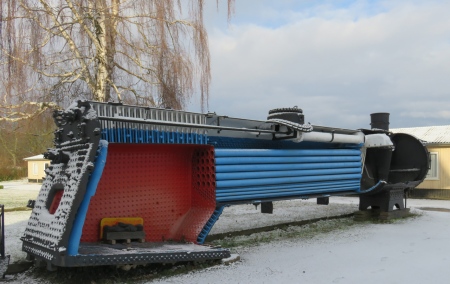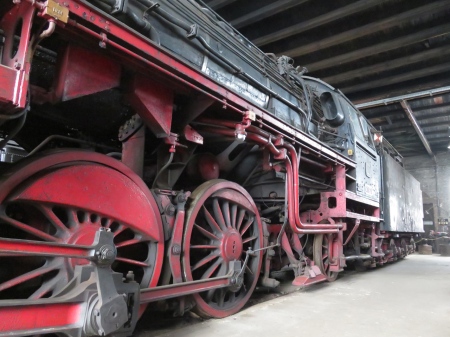Sunday 17 January 2016

The view out my window when I woke up. Only a few cm of snow, but not very inviting. But after a good breakfast, I Googled the Darmstadt attractions, thinking that I might, much against my usual habits, spend the day indoors, maybe even in a museum.
Well, I was half right. The attraction that attracted my eye was the railway museum at Kranichstein. Museum, just not indoors.
Ok, where’s Kranichstein? Found it on Google maps; it’s way the hell out in one of the nearby townlets. But when I ask Google for a walking route, well, it’s only 6,7 km. Ok, let’s head that way; if the weather is a disaster, we can always abandon the idea.

The day was okay, and although I am off the little throw-away paper map, I studied Google’s recommendation carefully enough that I had no trouble. You will observe that the latter part comprises staying right along the rail lines, so it was pretty easy.

The museum is open 10-4 on Sundays.

From this side, this is clearly the firing and steam generation part of a Lok. The other side is cut away, so we can see what’s going on.

Generally, red shows where the fire is, blue shows water, white is for steam. We can see how the firebox is immersed in water, including extracting heat through the flue pipes leading to the front.

To the left, the hole where the fireman shovels coal onto the grate.

Steam collects under the steam dome, whence it is channeled toward the superheater on the right.

Here, the superheater collecting the last possible energy from the flue gases, a screen to suppress sparks, and the chimney. This black cavity would presumably accumulate ash and need to be cleaned out from time to time.

Moving right along, the turntable itself. Roundhouse shops to the right.

A few Loks are left outdoors, almost humorous, some of them.


The humor in these is not so obvious, but they have no drive gear.

Going on into the roundhouse shops, we find Loks that are, many of them, roadworthy. The museum association sponsors steam-powered trips during the high season.

No mention of the world events into which these Loks fit. There must be stories. For better or worse, at least these machines survived.

While we looking at labels, this is a tender. Two interesting things here, first that steam propulsion consumed more water by volume than fuel Öl (oil). The second point is my extraction from what our volunteer tour guide said. It being all in German, I may have it completely wrong. For what it’s worth, I think he said that the oil was so heavy that it would not flow unless heated, so especially in cold weather, the fuel had to be heated before the fire could be started to heat the fuel. Clearly, there’s more to that story!

And while we on about signs, I thought it was interesting to see the typeface in use even in a heavy industry setting. Through the door, a machine shop, with overhead power shafts and leather belts running down to power individual machine tools.

Here, a standard blacksmith shop, presumably limited to things small enough, say, for one or two men to pick up.

I didn’t say anything about the group. Access by guided tour only; there were five of us visitors, including Junior here. Dad and Mom bracketing the tour guide, who was happy to explain things in simple detail to Junior and in more detail to Mom.

The fifth visitor was a guy who brought along a tripod and wandered around slightly away from the rest. I empathize.
One of several things I noticed for the first time today is that the counterweight cast into the wheel was sized according to the mass of iron that would otherwise unbalance the wheel.


As well as having the fuel solidify, it would really irritate your management if the water froze and started rupturing pipes and tanks.
This Lok was fitted out so we could climb up into the cab.



Remember seeing the grate in the cutaway exhibit earlier!
Junior decided he wanted to become a train-man and didn’t want to leave the cab. Good for him! (But he eventually did, of course, happily with no grumping on the part of anyone.)

From the stencils on some of the Loks, I observed that compressed-air brakes were not universal (well, of course not, not in the beginning: direct mechanical pressure was how you would naturally do it). And then they had air brakes, and the way to identify the air compressor is by the fins needed to dissipate the heat.

Whereas the assembly behind the tour guide here is a water pump. No fins.
Well worth the visit! Good show!
Walked back into Darmstadt on mostly the same route I had taken in the other direction. I thought this garbage incinerator was worth a foto: only steam coming from the stack. Their link says they burn 200.000 tons (metric tons) of garbage per year, but doesn’t say how much power they generate.



















































